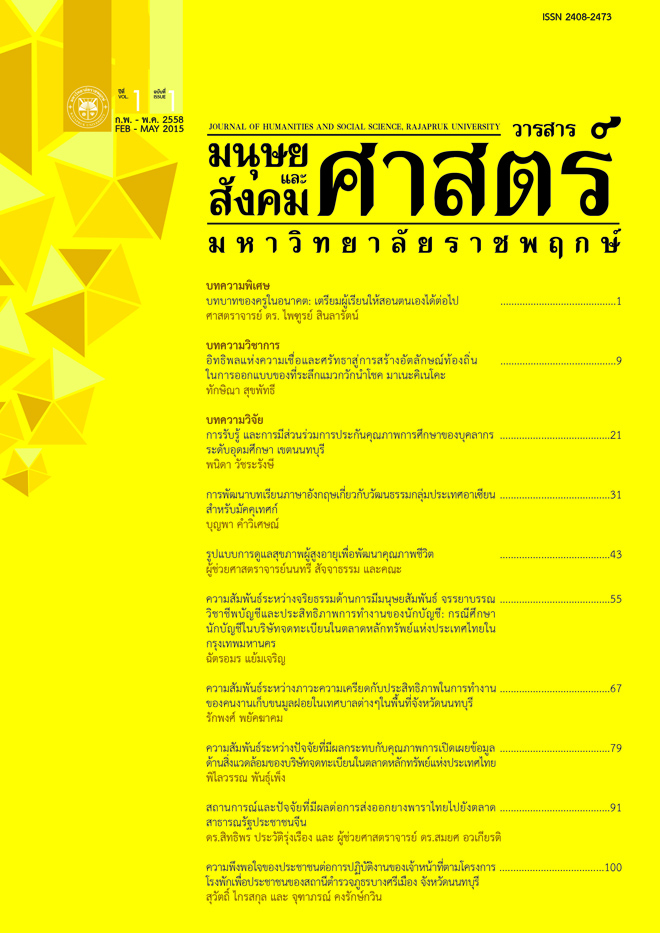The English Instructional Materials Development on Cultures of ASEAN Countries for Tourist Guides
Main Article Content
Abstract
The objectives of research were to develop and examine the efficiency of English instructional materials on ASEAN country cultures for tourist guides, compare students’ English learning achievement on ASEAN country cultures and study students’ opinions toward the developed materials. Thirty eight undergraduate students majoring in hotel and tourism management, who enrolled in English for Tourist Guide in the second semester academic year 2014 at Rajapruk University were purposively selected, the instruments used for this research were eight lessons developed by the researcher. An English reading test was used as a pre-test and post-test, and thirty questionnaires were used to gather the students’ opinions on the effectiveness of the eight lessons. The t-test was utilized to analyze the data in order to measure the subjects’ ability before and after using the lessons. The mean and standard deviation of the questionnaire scores were used to measure the students’ opinions toward the lessons
The results of this research were as follows: The effectiveness of the English Instructional materials was 74.00/76.32.This means that the efficiency of the lessons was at the acceptable level for the average of the formative test scores and at the good level for the students’ ability after using the lessons was significantly higher at the 0.05 level and the students’ opinions toward the eight English lessons on ASEAN country cultures were highly positive.
Article Details
References
มหาวิทยาลัย.
วีรชาติ ชัยเนตร. (2741). การสร้างบทเรียนเสริมการอ่านภาษาอังกฤษโดยใช้นิทานพื้นบ้านสำหรับ
นักเรียนชั้นมัธยมศึกษาปีที่ 4. วิทยานิพนธ์ปริญญามหาบัณฑิต สาขาวิชาภาษาอังกฤษ
มหาวิทยาลัยมหาสารคาม.
ธิญาดา ยอดแก้ว. (2547). การศึกษาสัญลักษณ์ทางวัฒนธรรมของประเทศในกลุ่มอาเซียน.
วิทยานิพนธ์ปริญญามหาบัณฑิต สาขาการสอนภาษาอังกฤษ มหาวิทยาลัยศิลปากร.
ดาว แสงบุญ. (2543). การสร้างเอกสารการสอนภาษาอังกฤษเพื่อการสื่อสารด้านการท่องเที่ยว
สาหรับนักศึกษาสาขาวิชาพัฒนาการท่องเที่ยว ชั้นปีที่ 3 มหาวิทยาลัยแม่โจ้ จังหวัด
เชียงใหม่. วิทยานิพนธ์ปริญญาศึกษาศาสตรมหาบัณฑิต สาขาวิชาการสอน ภาษาอังกฤษ
ในฐานะภาษาต่างประเทศ บัณฑิตวิทยาลัย มหาวิทยาลัยศิลปากร.
ทวีศักดิ์ ไชยมาโย และคณะ. (2541). การศึกษาปัญหาการใช้เทคนิคการสอนอ่านภาษาอังกฤษของ
ครูผู้สอนชั้นประถมศึกษาปีที่ 6 สานักงานการประถมศึกษาจังหวัดนครพนม.
วารสารวิชาการ. ปีที่ 1 ฉบับที่ 8, หน้า 80.
บูรชัย ศิริมหาสาคร. (2540). โลกาภิวัฒน์กับการพัฒนาการศึกษาไทย. สาร พัฒนาหลักสูตร ปีที่ 16 ฉบับที่128 หน้า 20.
วารินทร์ รัศมีพรหม. (2531). สื่อการสอน: เทคโนโลยีทางการศึกษาและการสอนร่วมสมัย.
กรุงเทพฯ: โรงพิมพ์ชวนพิมพ์.
วิสาข์ จัติวัตร์. (2528). การสอนอ่านภาษาอังกฤษตามแนวการสอนเพื่อการสื่อสาร. มิตรครู ปีที่15 ฉบับที่ 8 หน้า 15-19.
สุมณฑา วิรูหญาณ.(2531). ระดับความสามารถด้านการอ่านภาษาอังกฤษของนักเรียน ระดับ มัธยมศึกษาตอนปลาย. กรุงเทพฯ.จุฬาลงกรณ์มหาวิทยาลัย.
สุมิตรา อังวัฒนกุล. (2534). วิธีสอนภาษาอังกฤษ. กรุงเทพฯ: โรงพิมพ์จุฬาลงกรณ์ มหาวิทยาลัย.
เสงี่ยม โตรัตน์. (2734). การวิเคราะห์แบบเรียนภาษาอังกฤษ. นครปฐม: โรงพิมพ์มหาวิทยาลัย ศิลปากร วิทยาเขตพระราชวังสนามจันทร์.
อัจฉรา วงศ์โสธร. (2529). เทคนิคการสร้างข้อสอบภาษาอังกฤษ.กรุงเทพมหานคร:อักษรเจริญทัศน์.
Ahellal, M’barek. (1990). Using Authentic Materials in the Classroom: Theoretical Assumptions and Practical Considerations. TESOL Quarterly. 16, 8: 39. Heaton, J.B. (1990). Classroom Testing. Harlow: Longman.
Likert, R. (1932). A technique for the measurement of attitudes. Archives of Psychology. 140:1–55.
Moorman, G.B., and W.E. Blanton. (1990). The information text reading activity (ITRA): engaging students in meaningful learning. Journal of Reading.
Ogle, D. (1986). K – W – L : A teaching model that develops active reading of expository text. The Reading Teacher. 39: 564-570.


